Recently I saw this wood sign for sale in a catalog (available here, if you really want one):
Looking around online I found this t-shirt here, which combines the “My Indian name is” element with a twist on “kicks like a girl”:
I have seen things like this before, and they always irritate me (and I blame the movie “Dances with Wolves” for the whole “Indian names always follow the pattern ‘Present-Tense Singular Verb + With + Noun'” idea). There’s an element of othering here–the idea that American Indian names are funny or weird. Part of what I think is considered funny is that the names are presumably tied to actual activities or things (for example, Mankiller or Redbird). Of course, many European surnames originated the same way (for instance, “Smith” was a surname often used to indicate the person was a blacksmith, silversmith, etc.), but they now hold the status of “normal” surnames that are unremarkable (although Smith has become somewhat remarkable as a symbol of White non-ethnic normality, such that it is often used in movies and TV shows as an alias by spies and others wishing to avoid attention).
That website led me to this one, where there were lots of “Native American” t-shirts. As far as I can tell, it’s not a Native-owned company, it’s just a bunch of shirts with Native people or themes on them. Some, like these, associate American Indians with animals:
Whereas the t-shirts with men on them tend to show them in battle or hunting, those with women generally have romanticized, sometimes vaguely sexualized images. I noticed several have a common element: the upturned face, often with closed eyes, as well as stereotypically “Caucasian” features, except with darker skin and hair. This one is called “Purity”:
You might use these in a discussion of representations of Native Americans, particularly how they continue to be worn as symbols by other groups. The things associated with American Indians–wildlife (particularly wolves), nature, and the warrior tradition–tend to romanticize their connection to the natural environment and even portray them as part of nature themselves, able to communicate with the other “wild things.”
It’s a weird double bind: on the one hand, presumably American Indians are more “noble” than other groups–surely they wouldn’t have driven wolves, bald eagles, and bison to the verge of extinction, given their close connection to nature. But at the same time, they are depicted as relics of the past, brave fighters from the glory days. American Indians who drive cars and wear t-shirts and blue jeans (and have last names like Smith and Thomas) don’t have a place in our romanticized images of Native groups.
NEW! D. Cho sent in three more t-shirts that draw on Native American icons or images. Here is Spirit Happy Fox:
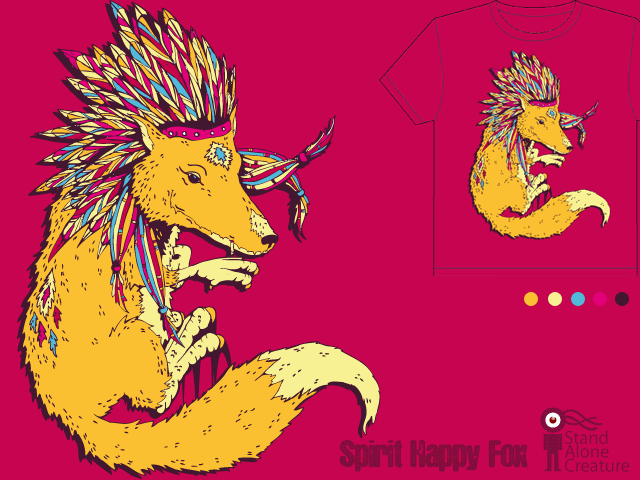
Chief Many Feathers:
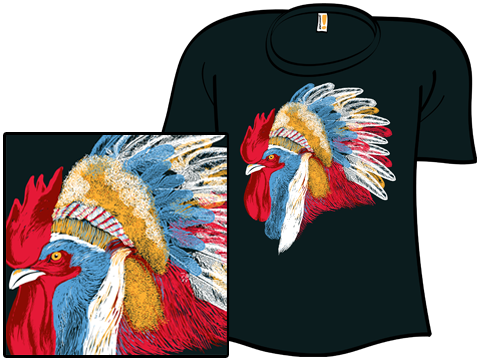
How the West Was Fun:
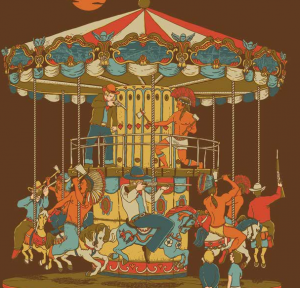

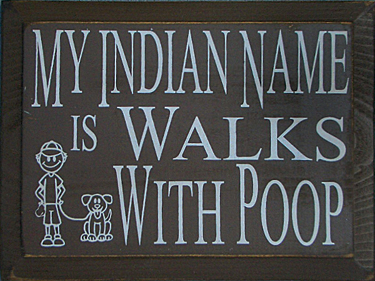
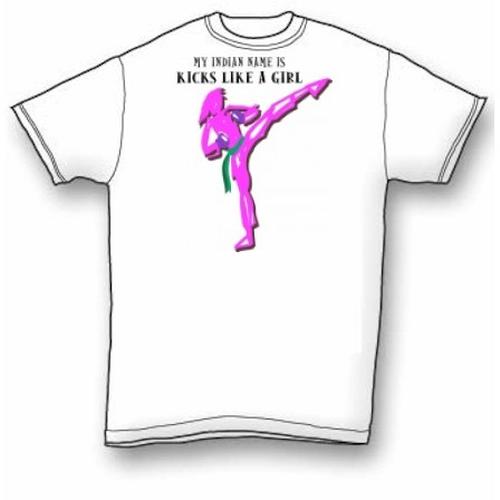
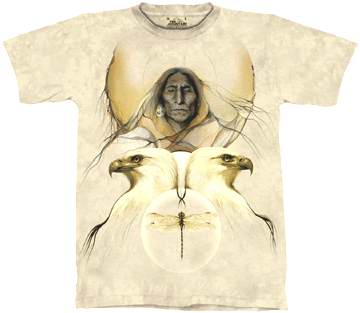

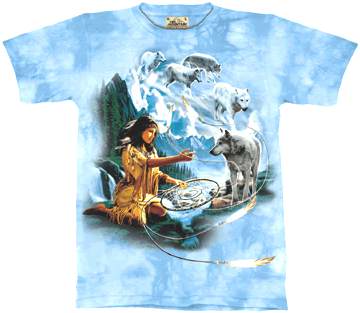
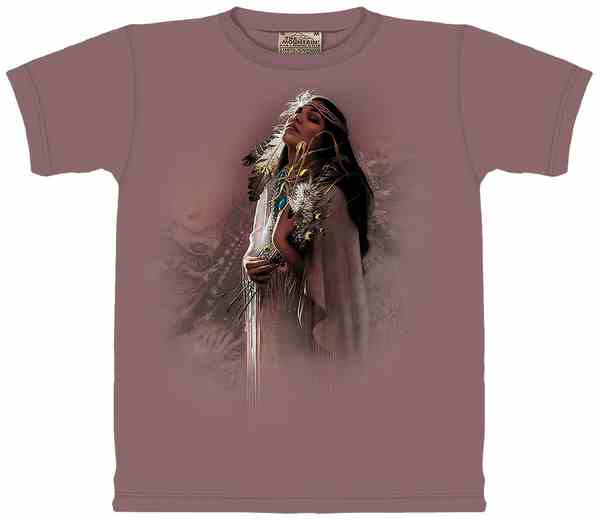
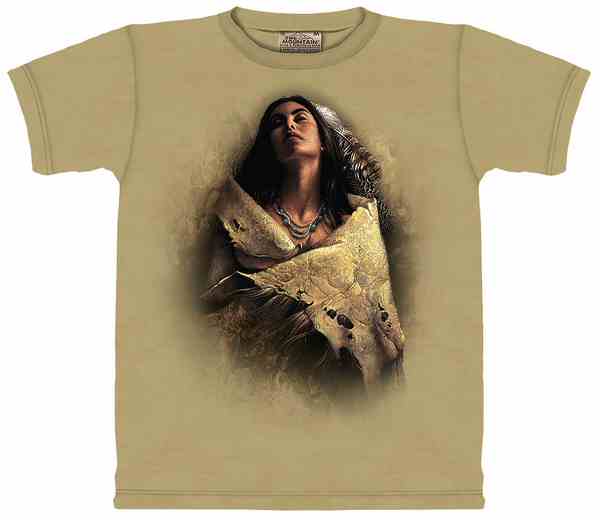
Comments 13
Vidya — November 9, 2008
It's interesting that some of these representations -- idealized figurines, Disney's Pocahontas, etc. -- seem to have gained some popularity among aboriginal people in the community in which I used to live. There is, of course, criticism by some persons as well; yet, my impression is that First Nations' peoples are often so desperate for 'positive' images of themselves and their histories, that these idealized representations are sometimes 're-appropriated' by natives. (I admit that it sits a little uneasily with me, given the fraught politics involved in appropriation in the first place.)
eallen — November 9, 2008
Beverly Slapin writes list of sarcastic recommendations for "How to Write a Historical Young Adult Novel with an Indian Theme for Fun and Profit," with examples taken from actual YA books. One of her comments concerns fake "Indian-sounding" names:
1. Name your characters in the traditional Indian way, using the formula that has been followed for decades: an adjective or participle followed by a noun. The adjective should be a color, the participle should imply animal or supernatural skills, and the noun should be an animal or natural occurrence or weapon. Young children are always named with a diminutive adjective followed by a predator (if a boy) or cute baby animal or form of flora (if a girl), and elders should always have the adjective “gray” in their names. If you are uncomfortable with the idea of making up names, go to authentic Indian sources. Just be sure that you cite them in your “author’s note.”
The rest of her trenchant comments can be read here: Beverly Slapin's essay.
K — November 9, 2008
Interesting stuff.
On the topic of adopting "foreign" names, I remember my brother's class, aged 8, having to adopt "French" names when they were in French lessons. My brother was distressed by this, partly because his assigned French name was nothing to do with his actual name. When I came to be a language assistant in France, the suggestion was made that our younger students might like to adopt "English" names for our classes. I never suggested this to them because I, too, find it all a bit bizarre. Also, it's very confusing for children who know each other's real names to remember what everyone else's alias is.
The other common "translation" of names I can think of is the forced translation of Scottish Gaelic or Welsh names when native speakers were forced to use English for school or work in the 20th century and earlier: Seamus becomes James, Ian or Sion becomes John, Seonaid or Sian becomes Jane. Those names, however, are etymologically the same, but it didn't always follow: Oifig often becomes Euphemia, which makes no sense until you consider that Oifig is pronounced (roughly) "Effie".
My grandparents were Smiths. They often went on trips with their friends the Browns, and occasionally had trouble convincing hotel receptionists that yes, those were their real names. You don't meet as many Smiths as you would think, given its status as the generic WASP name.
Eoin — November 10, 2008
Funny how you never see similar T shirts with representations of the Saami people of Finland on them. Or the gypsies of eastern Hungary? Good post.
sonicdeluxe — November 12, 2008
Me and a couple friends have sat around many a time coming up with Indian names for people. It's been an exercise in humor. BTW - one of mine is Eats Lots of Cheese.
Sociological Images » ANACHRONISM AND AMERICAN INDIANS — November 18, 2008
[...] them with feathers, buckskins, and moccasins. These anachronisms are everywhere (see, for example, here, here, here, here, and [...]
Appropriate This — November 27, 2008
How humiliating and degrading can these idiotic t-shirts be? Can you believe how many people still purport positive opinions as legitimate evidence that claims of offensiveness are wrong? Gah- NO one deserves to be dehumanized.
Even Shirt.Woot is not immune from ignorance:
http://shirt.woot.com/Friends.aspx?k=6506
Please don't patronize them; utilize Thanksgiving to decry this abberation. The shirt description is even more horrible.
Chloe — December 1, 2008
It's very true - this sort of stereotyping is degrading, yet I still caught myself smiling about the Walks with Poop sign (mostly because it took me a second to read it, and then I didn't understand why the word "poop" was so big).
This post reminds me of Sherman Alexie's books. He writes pretty bluntly about the realities of life on the conservation, and when it all comes down to it, romanticized visions of Pocahontas no longer (or rather, never did) show the real picture.
Rob Schmidt — December 4, 2008
For more on the subjects you've raised here, see "'Funny' Indian Names" (http://www.bluecorncomics.com/funnames.htm) and "Romanticized Indians" (http://www.bluecorncomics.com/romantic.htm).
usmanmalik12 — July 25, 2009
so cute shirts me asl malik usman ali nomania road, gujranwala pakistan
Culturally Appropriating Native Americans: A “Hands-on Approach to History” » Sociological Images — April 5, 2010
[...] skin is dark but my heart is white“, anachronistic images of Native Americans, “My Indian name is…“, the sports mascot Chief Illini, Playmobil’s Native American family, Howe Nissan [...]
Pkmn12 — February 26, 2012
Yeah modern Natives have our place but so to do the ones who came before and why shouldn't they be considered noble? Then we had true freedom and democracy as opposed to a corrupted mirror image. Who wouldn't want to return to that? That's the problem now - too much of the old wisdom is lost by most.
Resisting Dialogue: The Bear Hunt Statue at California School For the Deaf, Fremont — July 5, 2012
[...] behind the statue. The entire point of all of this is that POC are tired of our respective cultures being exploited to make a profit or to showcase another meaning. Our respective cultures are to valuable to us to [...]